Sapphire (Space Surveillance)
EO
ESA
Quick facts
Overview
| Mission type | EO |
| Agency | ESA |
| Launch date | 25 Feb 2013 |
Sapphire (Space Surveillance Mission of Canada)
Overview Spacecraft Launch Mission Status Sensor Complement Ground Segment References
The tracking of man-made objects (space debris) in Earth orbit is a crucial function for all spacefaring countries. With the international community on high-alert following an unprecedented satellite collision in early 2008, the Canadian Forces are working to re-establish a national space capability that could help protect Canadian satellites from orbital debris and other potential threats. Space surveillance keeps satellites from crashing into debris and into each other. 1)
The Canadian Department of National Defence (DND) is in the process of developing its own space surveillance system referred to as CSSS (Canadian Space Surveillance System). The objective of CSSS is to secure timely access to orbital data essential to Canada's sovereignty and national security by contributing to the deep space surveillance mission of the United States Space Surveillance Network (SSN) which maintains a global catalog of orbit elements for Resident Space Objects (RSOs). RSOs include active and inactive satellites, spent rocket bodies, and other pieces of orbital debris created by decades of human activity in space. According to a recent count of RSOs, the SSN catalog contains over 9000 space debris objects that are being monitored. The implementation and operation of CSSS will provide Canada an assured access to information on satellites and space debris in support of national sovereignty and operational missions.
Sapphire is a minisatellite system in LEO (Low Earth Orbit) that will form the centerpiece of the CSSS, providing an operationally flexible spaceborne platform for the precise tracking and identification of RSOs covering orbit altitudes in the range from 6000 - 40000 km. The Sapphire system, including the minisatellite, ground segment, launch, and operations, is currently (2010) being developed by MDA (MacDonald, Dettwiler and Associates) of Richmond, BC, as prime contractor for the Canadian DND, with a satellite launch scheduled for 2011. The Canadian government approved the CSSS project in 2007. 2) 3) 4)
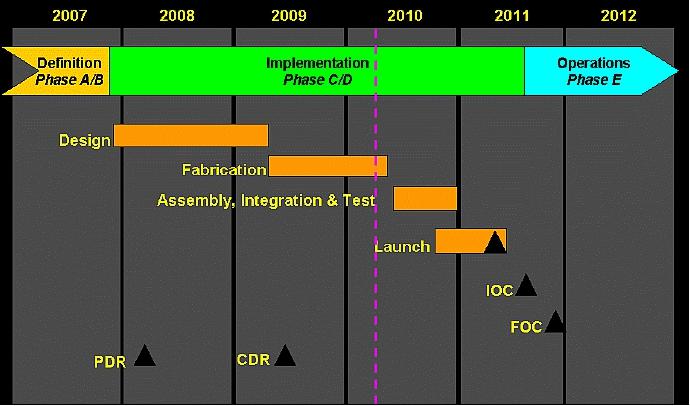
Background: The US SSN (Space Surveillance Network) is being operated by NORAD (North American Aerospace Defense Command) with HQs at the Patterson Air Force Base in CO, USA. NORAD is a joint organization of Canada and the United States that provides aerospace warning, air sovereignty, and defense for the two countries; it was created in 1958 when ballistic missiles became a threat. So far, the Canadian contribution to NORAD consisted in the provision of three ground-based telescopes in Canada functioning as space surveillance sensors. But the space situational awareness capability was lost by the CF (Canadian Forces) in 1992 when the last ground-based installation, referred to as Baker-Nunn (a type of large telescope and camera system), was decommissioned.
The newly established Sapphire initiative of Canada is considered a replacement for the retired Baker-Nunn ground based sensors, the goal is to feed the U.S. Air Force's SSN and gather data on objects reentering the Earth's atmosphere. In particular, the capability of the Sapphire project may potentially strengthen Canada's role and commitment in NORAD and increase Canada's access to information derived from U.S. space assets. 5) 6)
On May 4, 2012, the Canadian Armed Forces (CAF) signed a MOU (Memorandum of Understanding) with the U.S. Air Force. This military partnership will help increase Canada's awareness of where objects are located in space, enabling Canada to reduce the risk of loss of critical space capabilities, such as telecommunications, weather satellites, Earth observation satellites, and GPS. 7)
Overview of System Objectives and Requirements
A Sapphire mission overview is shown in Figure 2. The SSOC (Sensor System Operations Center) of DND will issue task lists to the Sapphire system. The purpose of these tasks is to generate up-to-date, accurate pointing vectors for Earth-orbiting objects, RSOs, which include active and inactive satellites as well as pieces of space debris. Sapphire will respond by commanding its spaced-based sensor to track and acquire images of the requested RSOs using an electrooptical telescope. The RSOs appear in these images as small points of light against a background of stars. The resulting images are downloaded from the Sapphire satellite to the ground segment for image data processing, which includes precise determination of the RSO direction in space based on identification of guide stars in each image. Tracking data products are created for the RSO tasks and transferred back to the SSOC, which is then responsible for transmission of contributing sensor data to the SSN.
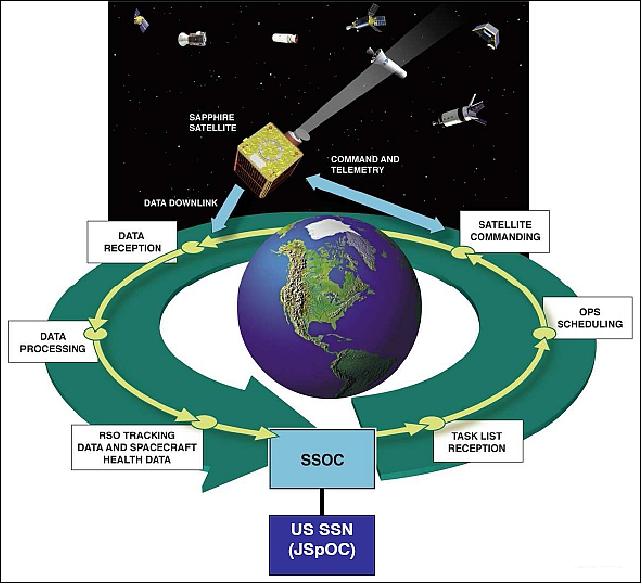
Sapphire must meet a set of demanding requirements in the categories of sensor performance, operations performance, and system robustness. The performance requirements are summarized in Table 1.
Category | Parameter | Requirement |
Sensor performance (detection and tracking of RSOs) | Tracking data accuracy of RSO vectors in geocentric reference frame | 6 arcsec (1?) |
RSO brightness range | Visual magnitudes 6 to 15 | |
Operations performance (delivery of the required data products to the customer) | Throughput | 360 RSOs/day |
Data latency | Less than 10 hours | |
Data security | Advanced encryption standard | |
System robustness | Mission lifetime | 5 years after commissioning |
Satellite reliability | 80% | |
System availability | 90%, with outages less than 7 days long |
System Architecture
The Sapphire system encompasses the following elements:
• The space segment, composed of a satellite bus and an electro-optical payload operating in the visible spectral band.
- The launch vehicle: Sapphire will be launched as a secondary payload on the PSLV (Polar Satellite Launch Vehicle) of ISRO and injected into a near circular, dawn-dusk sun synchronous orbit at a nominal altitude of 800 km.
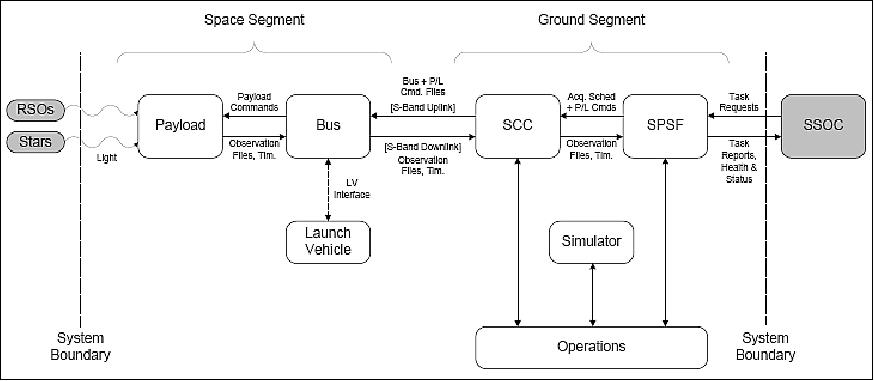
• The ground segment includes the following components:
- SPSF (Sapphire Processing and Scheduling Facility): located in the SOF (Sapphire Operations Facility) in Richmond, British Columbia. The SPSF provides the capabilities to accept task requests from the SSOC, schedule the RSO image acquisitions and create the associated payload command files, receive the collected RSO imagery, and process it into RSO tracking data for delivery to the SSOC. The SPSF also provides support for system calibration, which is performed throughout the mission.
- SCC (Satellite Control Centre): SCC provides all the capabilities to command the satellite and receive telemetry and image data. The SCC includes a primary S-band antenna ground station for satellite telemetry, tracking, and command (TTC) located in Abbotsford, British Columbia. The primary SCC control room computers reside in the SOF. - Sapphire will also use a secondary SCC service to communicate with the satellite through the SSTL (Surrey Satellite Technology Limited) ground station network in the UK.
- Simulator: located in the SOF. Supports the development of operations procedures and training of system operators.
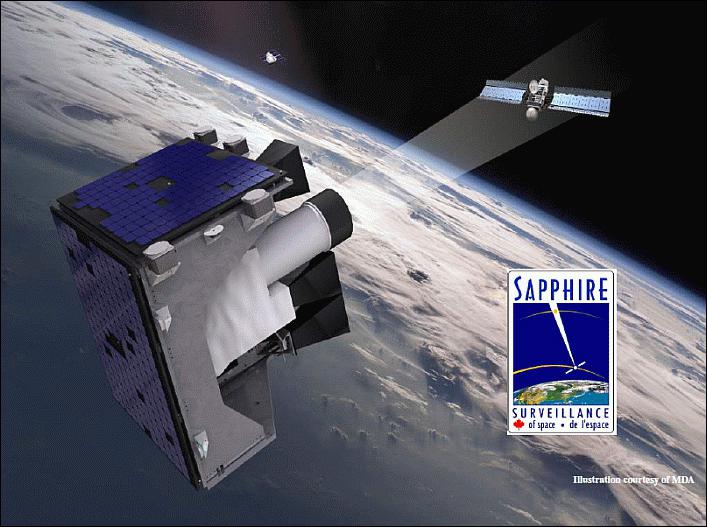
Spacecraft
The Sapphire spacecraft is being developed by SSTL (Surrey Satellite Technology Ltd.) of Guildford, UK. MDA as project prime contractor awarded a contract to SSTL for delivering the spacecraft, COM DEV was contracted to build the payload, and Terma of Denmark received a contract to deliver a data processing chain as part of the Sapphire space object surveillance program. 8)
The minisatellite is based on the SSTL-150 bus (of DMC+4 (Beijing-1), TopSat, and RapidEye mission heritage) providing a payload accommodation of 50 kg (max) and 50 W of power on a minisatellite of 150 kg total mass. The bus provides the structural, power, and communications interfaces to the payload. The bus is responsible for receiving and interpreting command files from the ground segment via an encrypted and authenticated link and controlling the satellite attitude in order to point the payload OIS (Optical Imaging Subsystem) towards the target RSOs. The bus slews the satellite between RSO targets and sets up a stable tracking trajectory for each RSO observation period. The bus also forwards imaging command files received from the ground to the payload. In addition to this, the bus is responsible for receiving and storing image, ancillary and housekeeping telemetry files from the payload until the data can be transmitted to the ground segment over an S-band radio frequency (RF) link (Ref. 3).
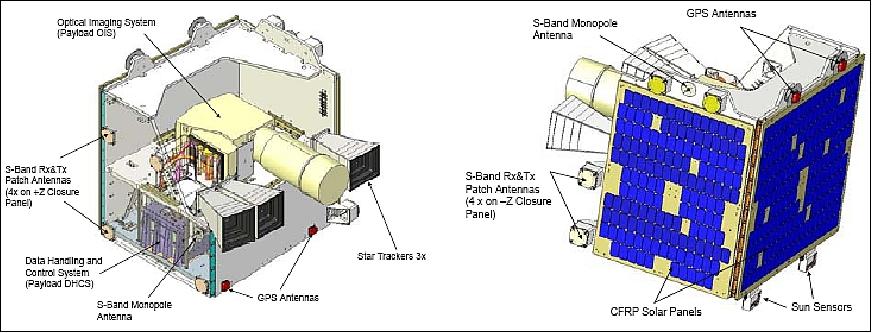
Since MDA was the prime contractor of the RapidEye constellation that was built by SSTL, the primary structure, avionics, and power system of the Sapphire spacecraft are largely being reused elements from the design of the RapidEye satellites (launch on August 29, 2008). Some RapidEye elements that have been changed for Sapphire include: the star trackers, the battery, and the solar panel technology. All of these new items have flight heritage on other missions.
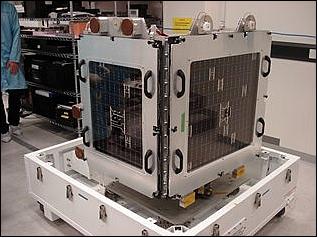
Launch: The Sapphire minisatellite was launched as a secondary payload on Feb. 25, 2013 on the PSLV-C20 launcher of ISRO from the SDSC (Satish Dhawan Space Centre), Sriharikota, on the east coast of India. The primary payload is SARAL a collaborative mission of ISRO and CNES. 9) 10) 11)
Orbit: Sun-synchronous near-circular dawn-dusk orbit, altitude of ~ 786 km, inclination of 98.55o, orbital period of 100.6 minutes, LTAN (Local Time on Ascending Node) = 6:00 hours, repeat cycle = 35 days (No of orbits within a cycle = 501).
RF communications: The heritage S-band subsystem provides a downlink data rate of 4 Mbit/s.
Secondary Payloads
• BRITE-Austria (CanX-3b) and UniBRITE (CanX-3a), both of Austria. UniBRITE and BRiTE-Austria are part of the BRITE Constellation, short for "BRIght-star Target Explorer Constellation", a group of 6.5 kg, 20 cm x 20 cm x 20 cm nanosatellites who purpose is to photometrically measure low-level oscillations and temperature variations in the sky's 286 stars brighter than visual magnitude 3.5.
• Sapphire (Space Surveillance Mission of Canada), a minisatellite with a mass of 148 kg.
• NEOSSat (Near-Earth Object Surveillance Satellite), a microsatellite of Canada (DND) with a mass of ~74 kg.
• AAUSat3 (Aalborg University CubeSat-3), a student-developed nanosatellite (1U CubeSat) of AAU, Aalborg, Denmark. The project is sponsored by DaMSA (Danish Maritime Safety Organisation).
• STRaND-1 (Surrey Training, Research and Nanosatellite Demonstrator), a 3U CubeSat (nanosatellite) of SSTL (Surrey Satellite Technology Limited) and the USSC (University of Surrey Space Centre), Guildford, UK. STRaND-1 has a mass of ~ 4.3 kg.
Mission Status
• February 2015: The CAF (Canadian Armed Forces) operates the SSOC (Sensor System Operations Centre), located at CFB North Bay Ontario, which manages taskings and correlates, manages, archives and forwards the Sapphire data to the United States Air Forces JSpOC (Joint Space Operations Center). The Canadian Forces reported in 2014 that Sapphire was exceeding its design specifications and is making a valuable contribution to the United States SSN (Space Surveillance Network). 12)
- The United States Air Forces Space Surveillance Network is made up of ground-based radar and optical sensors as well as several space-based sensors. In general terms, the ground-based radar sensors are used primarily for detection and tracking of LEO (Low Earth Orbit) objects and optical sensors are primarily focused on objects in MEO (Medium Earth Orbit) and GEO (Geostationary Earth Orbit).

- Sapphire is one of five spaceborne sensors used to monitor satellites and debris. The United States Air Force operates the SBSS (Space-Based Satellite Surveillance) satellite (launched on Sept. 26, 2010), two GSSAP (Geosynchronous Space Situational Awareness Program) satellites (launched on July 28, 2014) 13) as well as the STSS ATRR (Space Tracking and Surveillance System Advanced Technology Risk Reduction) satellite (also known as USA-205, launched on May 5, 2009 and transferred to US Air Force Space Command on Jan. 31, 2011). The SBSS (Space Based Satellite Surveillance) satellite is a capability similar to Sapphire, but significantly more expensive.
- As successful as the Sapphire satellite is, it does have a finite design life and a replacement project is listed in the Defence Acquisition Guide as the SofS 2 (Surveillance of Space 2) project. According to the Guide, Surveillance of Space 2 should enter the project definition phase in 2015 with a delivery as early as 2021, a full eight years after Sapphire's launch, which has a five year design life. However, given the heritage of Canadian microsatellites (both SciSat and MOST are operating 10 years after launch), Sapphire should remain operational until a replacement capability is developed.
• January 30, 2014: MDA announced today that the Sapphire satellite, developed by MDA for Canada's DND (Department of National Defence), has completed its commissioning phase and is fully transitioned into operations as a contributing sensor to the U.S. Space Surveillance Network. With the declaration of full operational capability, Sapphire will enter its five-year operational phase. Data from this satellite will be incorporated into an international catalog that is used to help prevent collisions in space. 14) 15)
• Initial Operational Capability (IOC) signed on September 10, 2013. 16)
• Launch and Early Orbit Phase (LEOP) successfully completed on May 29, 2013.
• On Feb. 25, 2013, MDA reported that communication with the Sapphire satellite had been established.
Sensor Complement
OIS (Optical Imaging Subsystem)
COM DEV International Ltd. of Cambridge, Ontario provided the Sapphire optical payload which consists of the Optical Imaging Subsystem (OIS) and the DHCS (Data Handling and Control Subsystem). Sapphire will provide timely, accurate tracking data on Earth-orbiting RSOs (Resident Space Objects). During operation, the agile Sapphire spacecraft is commanded to the desired orientation, and then a series of images are acquired by the Sapphire payload which is fixed relative to the spacecraft body. The images are time tagged and telemetered to the ground. 17) 18) 19)
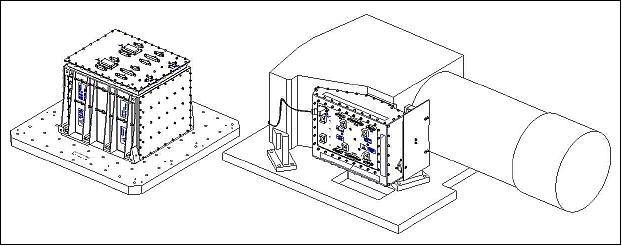
OIS includes an off-axis TMA (Three Mirror Anastigmat) telescope, its associated CCD (Charge Coupled Device) detector system with an FPA (Focal Plane Assembly), and the CCD preamplifiers. The DHCS (Data Handling and Control Subsystem) includes the sensor readout electronics, the payload instrument controller, and the power supply assembly for power distribution to the payload units.
Telescope: The optical portion of the OIS telescope was designed and built by L-3 Communications SSG Tinsley, in Wilmington, Massachusetts, USA. The OIS telescope is based on the design of the SBV (Space Based Visible) telescope that flew on the MSX (Midcourse Space Experiment) satellite of DoD (launch April 24, 1996). The mission of SBV is very similar to the Sapphire mission – SBV was the first demonstration of "surveillance of space" from a spaceborne platform.
Since OIS and SBV share the same basic telescope architecture and properties, the following parameters can be cited:
- Three-mirror Anastigmat (TMA) off-axis imaging optical design. MDA has flight experience with this class of telescope as the RapidEye payload features an all-aluminum TMA. This architecture is considered to be a low-risk, well-suited technology for the Sapphire application.
- All aluminum housing and mirror substrates
- Similar aperture size (of ~15 cm)
- Spectral range of 0.3 - 0.9 µm
- Excellent stray light rejection.

As can be seen in Figure 9, the payload consists of the OIS (Optical Imaging Subsystem) and the DHCS (Data Handling and Control Subsystem). Designed for a LEO lifetime of 5 years, the imager is comprised of a baffled TMA similar to the Space-Based Visible (SBV) sensor, feeding dual-redundant back-illuminated frame-transfer CCDs, each capable of low-noise imaging in a 1.4o x 1.4o FOV. The readout electronics, and data handling and control system are also dual redundant with no cross-strapping. The DHCS can correct the images that have been captured and compress the image data before it is transmitted to a ground station for additional processing.
The Sapphire payload has a mass of 28.5 kg, and is comprised of 18.8 kg for the telescope, 8.1 kg for the electronics and 1.6 kg for the harnessing. The average power consumption is 14 W, with periodic increases to 20 W to support internal modes of operation. The image output data rate from the payload is 10 Mbit/s.
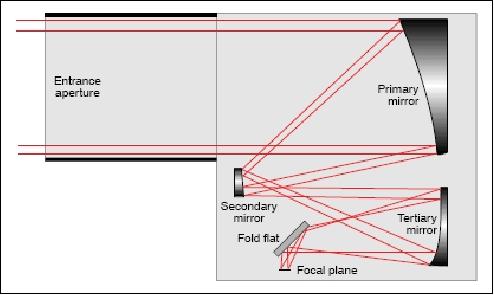

The OIS FPA was designed and built by e2v Technologies plc of Chelmsford, UK. The FPA consists of two CCD detectors (the prime and redundant units) mounted onto an invar adaptor plate with flex harness connections for interfacing to the OIS pre-amp assembly.
The CCD detector array [CCD47-20bi, back illuminated, providing AIMO (Advanced Inverted Mode Operation) support] has an active area of 1024 x 1024 pixels, with an average of 8 individual images acquired per RSO task. Assuming 360 RSO tasks per day and 16-bit storage per pixel, this leads to a total payload data volume of over 6 GByte per day. Hence, some form of image data compression is required onboard the spacecraft (by a factor of at least 6) to avoid a redesign of the heritage communications subsystem.
On-orbit performance (Ref. 19):
COM DEV has analyzed 14-bit image data provided by MDA and has performed an initial evaluation of the on-orbit performance of the Sapphire optical payload. The mission payload is working well on-orbit, meeting its specifications, with on-orbit performance in line with pre-launch expectations. The instrument is providing sharp, low-noise low-distortion images at a pixel scale of 5 arcsec. The imaging performance requirement is to contain 85% of the target energy in a 3 x 3 pixel region (15 arcsec x 15 arcsec).
Figure 12 shows that the Sapphire spacecraft attitude control system is working well, adding negligible blurring from pointing drift over 4 second frames. There is no evidence of jitter or contamination degrading the image quality or throughput. Multiple images of the same field are co-aligned to <1 pixel. The system was designed to detect objects from 6th to 15th magnitude and locate them on the sky to within a 1? accuracy of 6 arcseconds. The optical payload is required to detect a 15th magnitude object moving across the field at 4 arcsec/s with a SNR of 6.5:1. The sharpness of the imaging that is being achieved means that the system can actually detect objects 2.5 times fainter than required at the same positional accuracy (16th magnitude).
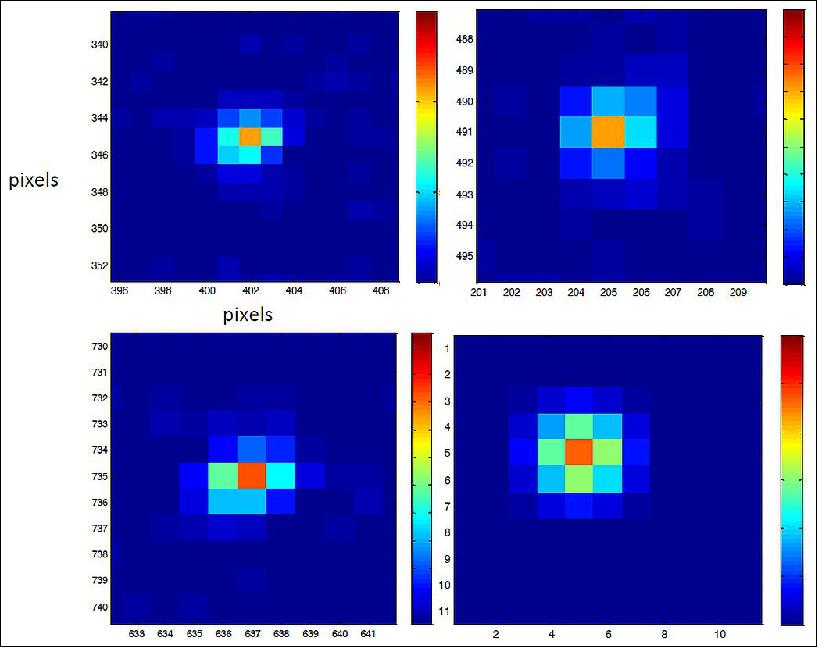
Figure 13 is a raw image histogram measured using dual correlated subtraction with full width at half maximum (FWHM) of ~3 counts or 25 electrons. The asymmetry in the plot is mainly due to starlight. We were able to identify only 862 isolated hot pixels above a 10 count threshold (<0.01% of all pixels).
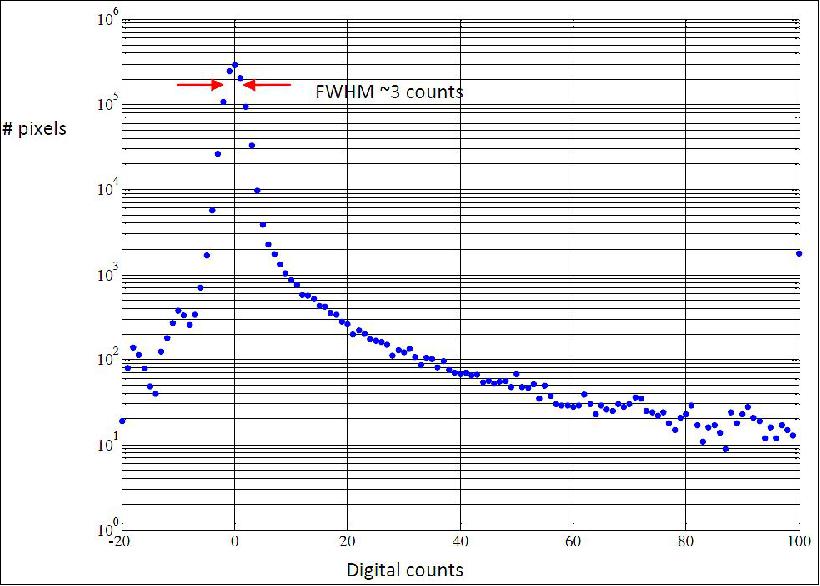
Ground Segment
The ground segment elements are listed under "System Architecture." The ground segment of the Sapphire System is composed of a Spacecraft Control Center (SCC), a Satellite Processing and Scheduling Facility (SPSF), and the Sapphire Simulator.
Terma of Copenhagen, Denmark, was selected to design and build the SPSF (Sapphire Processing and Scheduling Facility). This computer system contains the algorithms for processing the downloaded Sapphire imagery, establishing the precise attitude of stars and RSOs in the images, and creating RSO tracking data products. Terma has extensive experience in this type of image processing application as they also design and manufacture space flight star trackers. By leveraging off their domain expertise and access to heritage models and algorithms, Terma is able to produce a compact, robust data processor for Sapphire.
MDA's responsibilities under the contract will include relaying assigned taskings from the DND to the satellite, processing the collected information, and sending the data to the SSOC (Sensor System Operations Centre) operated by DND at the 22 Wing in North Bay, Ontario. Once the processed data is received, the SSOC will correlate, identify, archive and transmit the information to the United States' JSpOC (Joint Space Operations Center).
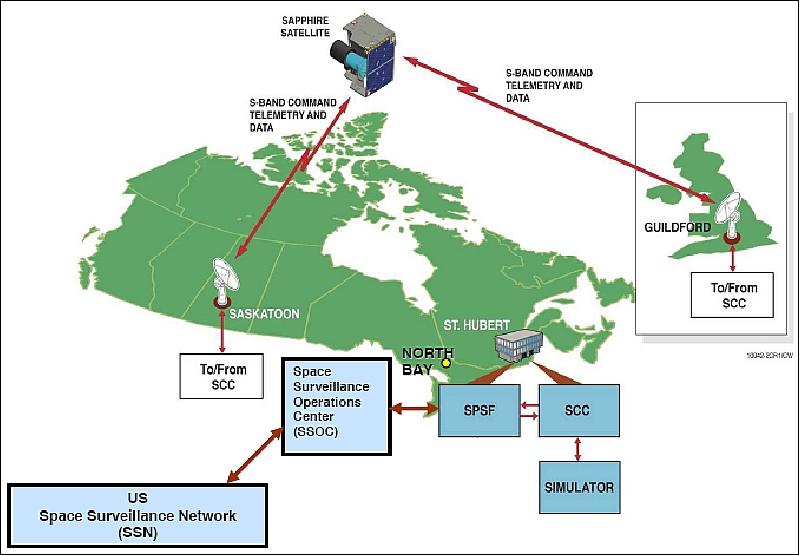
In 2014, the CAF (Canadian Armed Forces) established a CANSpOC (Canadian Space Operations Center), a counterpart of the US JSpOC, to provide a wide range of services to the Commander Canadian Joint Operations Command, including missile warning, notification of space launches, satellite conjunction analysis (through its partnership with the US Joint Space Operations Center), reentry predictions, reporting of satellite electronic interference, reporting of GPS accuracy, status reporting of Canadian and allied space systems that support CAF operations (Sapphire, SATCOM systems, missile warning sensors, space weather events, etc) reporting of space events, warnings and threat assessments and both deliberate and contingency planning. In addition, the CANSpOC can deploy up to two teams anywhere in the world to provide space-related operational support and advice to a deployed task Force Commander. 20)
Original plans for the CANSpOC also included an ability to independently conduct space surveillance tasks like satellite conjunction analysis. This capability would rollout in later years and would depend on an agreement between all stakeholders, most importantly the US Joint Space Operations Center and the Canadian Space Agency.
References
1) Myles Gough, "Incoming - warnings of trouble from space," URL: http://www.carleton.ca/catalyst/
gough/gough.html
2) Paul Maskell, Lorne Oram, "Sapphire: Canada's Answer to Space-Based Surveillance of Orbital Objects," 2008, URL: http://www.amostech.com/TechnicalPapers/2008/SSA_and_SSA_Architecture/Maskell.pdf
3) Robert Leitch, Ian Hemphill, "Sapphire: A Small Satellite System for the Surveillance of Space," Proceedings of the 24th Annual AIAA/USU Conference on Small Satellites, Logan, UT, USA, Aug. 9-12, 2010, SSC10-II-3, URL: http://digitalcommons.usu.edu/cgi/viewcontent.cgi?article=1194&context=smallsat
4) Nicole Sabourin, "Sapphire: Canada's Answer to Space-Based Surveillance of Orbital Objects," Proceedings of ASTRO 2010, 15th CASI (Canadian Aeronautics and Space Institute) Conference, Toronto, Canada, May 4-6, 2010
5) "CF regains surveillance of space operational capability," The Maple Leaf, Jan. 11, 2006, Vol. 9, No 2
6) James Fergusson, Stephen James, "Report on Canada, National Security and Outer Space," June 2007, URL: http://www.cdfai.org/PDF/Canada%20National%20Security%20and%20Outer%20Space.pdf
7) "Space Situational Awareness and the Sapphire Satellite," January 30, 2014, Backgrounder, URL: http://news.gc.ca/web/article-en.do?nid=812899
8) "Terma Delivers Data Processing Chain For Canadian Satellite Program," Space Mart, March 7, 2008, URL: http://www.spacemart.com/reports/Terma_Delivers_Data_Processing_Chain_For_
Canadian_Satellite_Program_999.html
9) "PSLV - C20 successfully launches Indo-French satellite SARAL and six other commercial payloads into the orbit," ISRO, Feb. 25, 2013, URL: http://www.isro.org/pslv-c20/c20-status.aspx
10) "The Canadian Sapphire satellite is successfully launched," Royal Canadian Air Force, Feb. 25, 2013, URL: http://www.rcaf-arc.forces.gc.ca/v2/nr-sp/index-eng.asp?id=13644
11) "SSTL's 40th satellite platform launch: Sapphire reaches orbit," Space Daily, Feb. 26, 2013, URL: http://www.spacedaily.com/reports/SSTLs_40th_satellite_platform_launch
_Sapphire_reaches_orbit_999.html
12) Marc Boucher, Andre Dupuis, "An Overview of Canadian Military Space in 2014 - Part 2," Space Ref Canada, Feb. 17, 2015, URL: http://spaceref.ca/military-space/an-overview-of-canadian-military-space-in-2014---part-2.html
13) "Geosynchronous Space Situational Awareness Program (GSSAP)," Air Force Space Command, April 15, 2015, URL: http://www.afspc.af.mil/library/factsheets/factsheet.asp?id=21389
14) "MDA announces Canada's DND Sapphire satellite completes commissioning and has transitioned into operations," MDA, Jan. 30, 2014, URL: http://www.mdacorporation.com/corporate/news/
15) "News Release - Sapphire satellite system is declared fully operational," National Defence and the Canadian Armed Forces, January 30, 2014, URL: http://www.forces.gc.ca/en/news/article.page?doc=sapphire-satellite-system-is-
declared-fully-operational/hr1thk2x
16) David Kendall, "Advances in Canada's Contributions to Space Situational Awareness," Proceedings of the 51st Session of Scientific & Technical Subcommittee of UNCOPUOS, Vienna, Austria, Feb. 11-22, 2014, URL: http://www.unoosa.org/pdf/pres/stsc2014/tech-23E.pdf
17) J. Hackett, R. Brisby, K. Smith, "Overview of the Sapphire payload for space surveillance," Proceedings of SPIE, ' Sensors and Systems for Space Applications V', Vol. 8385, Baltimore, MD, USA, April 23, 2012, doi:10.1117/12.921668
18) John Hackett, Lisa Li, "Sapphire-like Payload for Space Situational Awareness," AMOS 2012, URL: http://www.amostech.com/TechnicalPapers/2012/POSTER/HACKETT.pdf
19) Alan Scott, John Hackett, Kam Man, "On-Orbit Results for Canada's Sapphire Optical Payload," 2013 AMOS (Advanced Maui Optical and Space SurveillanceConference), Sept. 2013, URL: http://www.amostech.com/technicalpapers/2013/space-based_assets/scott.pdf
20) Marc Boucher, Andre Dupuis, "An Overview of Canadian Military Space in 2014 - Part 1," Space Ref Canada, Feb. 9, 2015, URL: http://spaceref.ca/military-space/an-overview-of-canadian-milspace-in-2014---part.html
The information compiled and edited in this article was provided by Herbert J. Kramer from his documentation of: "Observation of the Earth and Its Environment: Survey of Missions and Sensors" (Springer Verlag) as well as many other sources after the publication of the 4th edition in 2002. - Comments and corrections to this article are always welcome for further updates (eoportal@symbios.space).
Overview Spacecraft Launch Mission Status Sensor Complement Ground Segment References Back to top